Attached files
| file | filename |
|---|---|
| 8-K - REHABCARE GROUP INC | eightk1q2010presentation.htm |
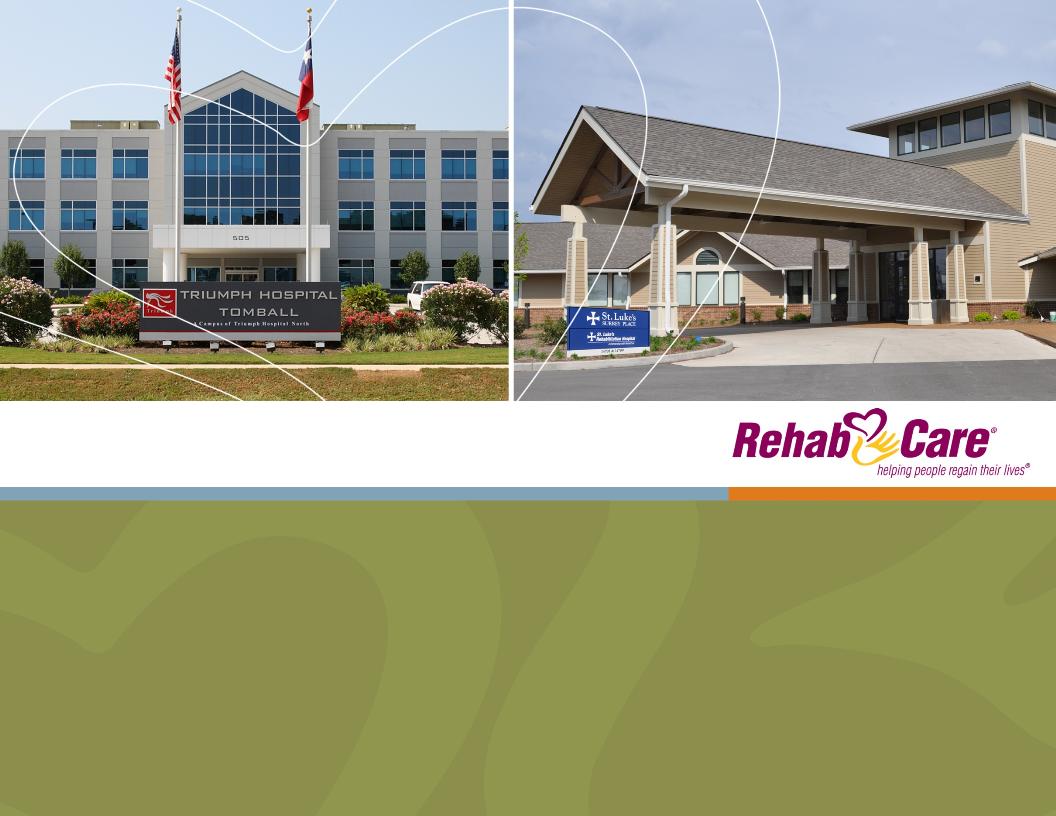
Investor Presentation
First Quarter 2010
Exhibit 99
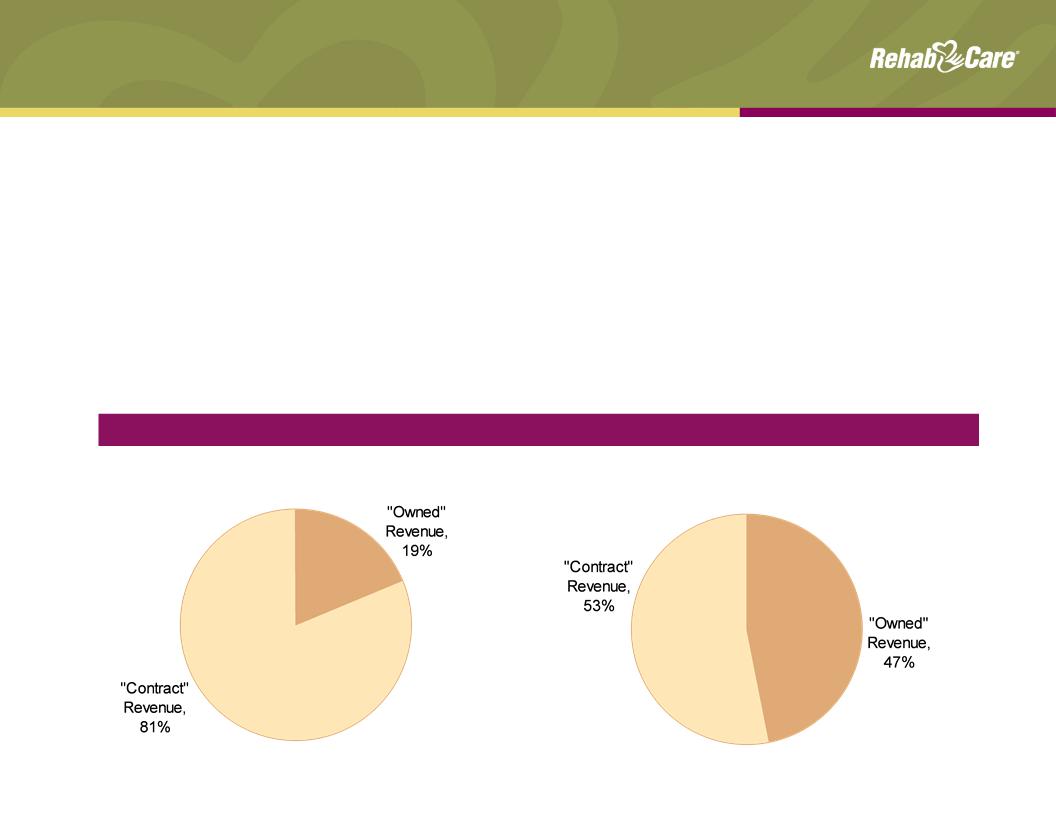
n Headquartered in St. Louis, MO
n Established in 1982
n Largest contract manager of rehabilitation services; fourth largest post-acute hospital
operator, third largest long-term acute care hospital provider
operator, third largest long-term acute care hospital provider
n Triumph HealthCare merger created more diversified business lines, reducing reliance on
management contracts for revenue and EBITDA streams
management contracts for revenue and EBITDA streams
1
FYE 2009 “Owned” Revenue vs. “Contract” Revenue
RehabCare ex. Triumph
Pro Forma w/Triumph
Company Overview
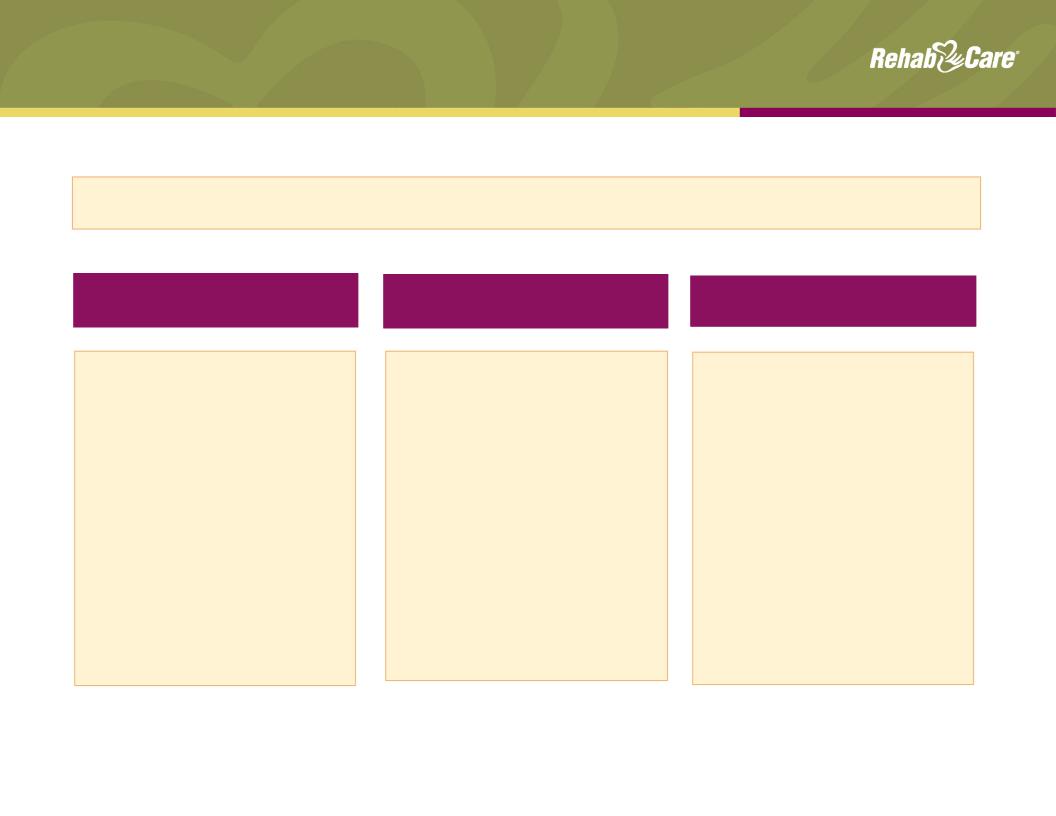
Division Overviews
Skilled Nursing Rehabilitation
Services (SRS)
Services (SRS)
n $499 mm - 39% of pro forma
revenue
revenue
n 1,125 SNF/long-term care
programs in 37 states
programs in 37 states
n 8.1 mm annual patient visits
n Polaris Group - consulting for
long-term care facilities
long-term care facilities
n VTA Management Services -
therapy and nurse staffing for
New York
therapy and nurse staffing for
New York
$1.3 billion pro forma operating revenues for LTM 3/31/10
Hospital Rehabilitation
Services (HRS)
n $178 mm - 14% of pro forma
revenue
revenue
n 144 hospital-based programs
in 32 states
in 32 states
n 43,000 IRF discharges/year
n 1.2 mm annual outpatient
visits
visits
n $594 mm - 47% of pro forma
revenue
revenue
n 29¹ LTACHs, 6 IRFs; 13 states
n 20 FS LTACHs, 9 HIHs; 4 FS
IRFs, 2 HIHs
IRFs, 2 HIHs
n 1,593 licensed LTACH beds;
243 IRF beds
243 IRF beds
n 410,000 annual patient days
LTACHs = Long-Term Acute Care Hospitals
IRFs = Inpatient Rehabilitation Facilities
SNFs = Skilled Nursing Facilities
FS = Freestanding
HIH = Hospital in Hospital
Hospital Division
2
1Includes Triumph Hospital-The Heights, which opened in April
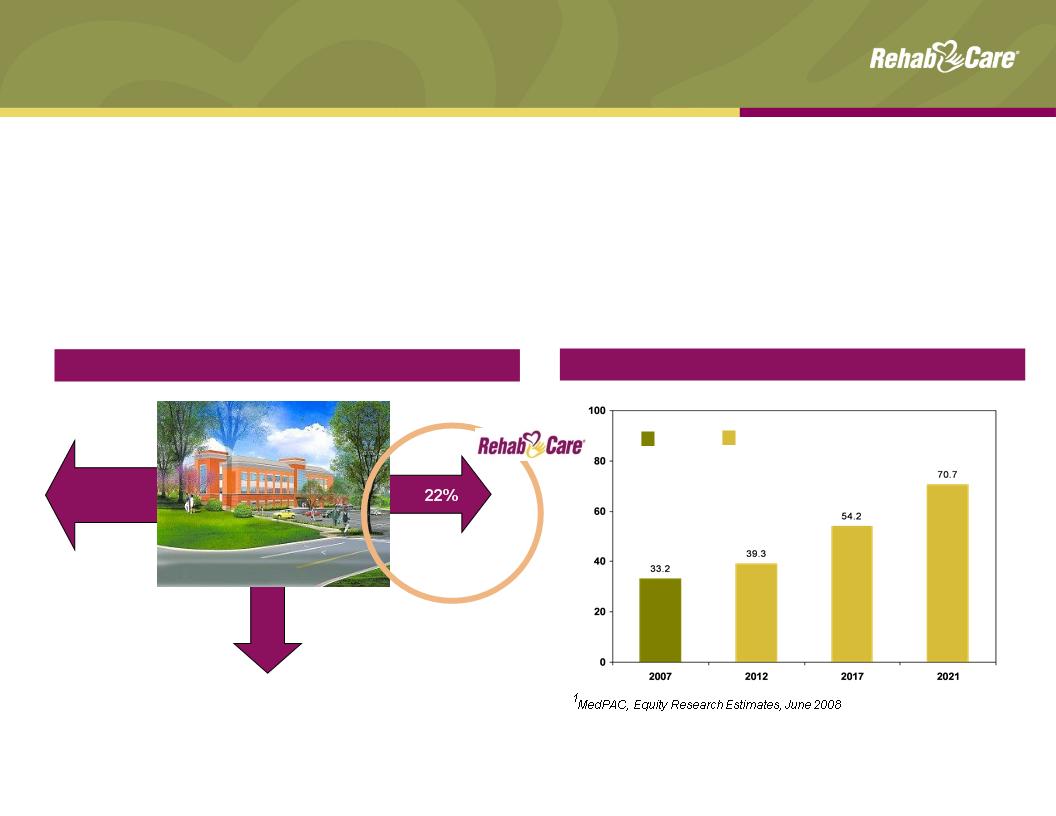
13%
Patient Discharge Destination1
LTACH / SNF
IRF
No post-
acute care
acute care
Hospice/Home Health
65%
Acute care
hospital
hospital
3
Market Overview
2MedPAC Data Book, June 2009; does not include Home Health or
Medicare Advantage
Medicare Advantage
3Avalere Health LLC, April 2009; does not include Home Health or
Medicare Advantage
Medicare Advantage
Medicare Post-Acute Spending (in billions)
$
n Large, growing and highly fragmented market
n Positive demographic trends, with first wave of Baby Boomers entering Medicare in 2011
n Medicare expenditures for post-acute services (excluding home health) projected to
increase 113% from 2007 to 2021
increase 113% from 2007 to 2021
n RehabCare delivers services across the post-acute continuum of care, providing
the most appropriate discharge destination for acute patients
the most appropriate discharge destination for acute patients
Projected3
Actual2
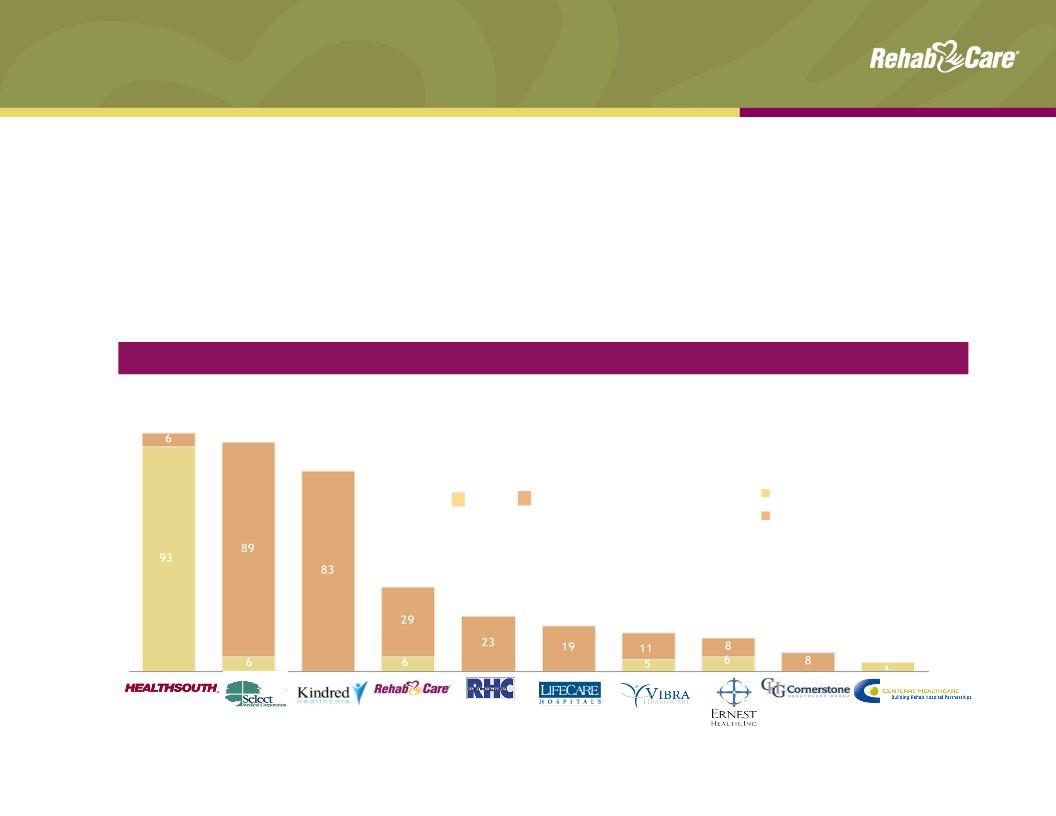
Hospital Division
Overview
Overview
Competitive Landscape
1MedPAC, March 2010 Report to the Congress
2Includes Triumph Hospital-The Heights, which opened in April
n RehabCare pursues joint venture hospital partnerships (nine currently,
representing 15 locations) with market-leading acute care providers and physician
groups, in addition to its wholly owned facilities
representing 15 locations) with market-leading acute care providers and physician
groups, in addition to its wholly owned facilities
Market Size1: 221 IRFs
(Freestanding and HIHs)
Market Size1: 386 LTACHs
IRFs
LTACHs
4
Source: Information available from public filings or
from company websites
from company websites
99
95
83
35
23
19
16
14
8
4
2
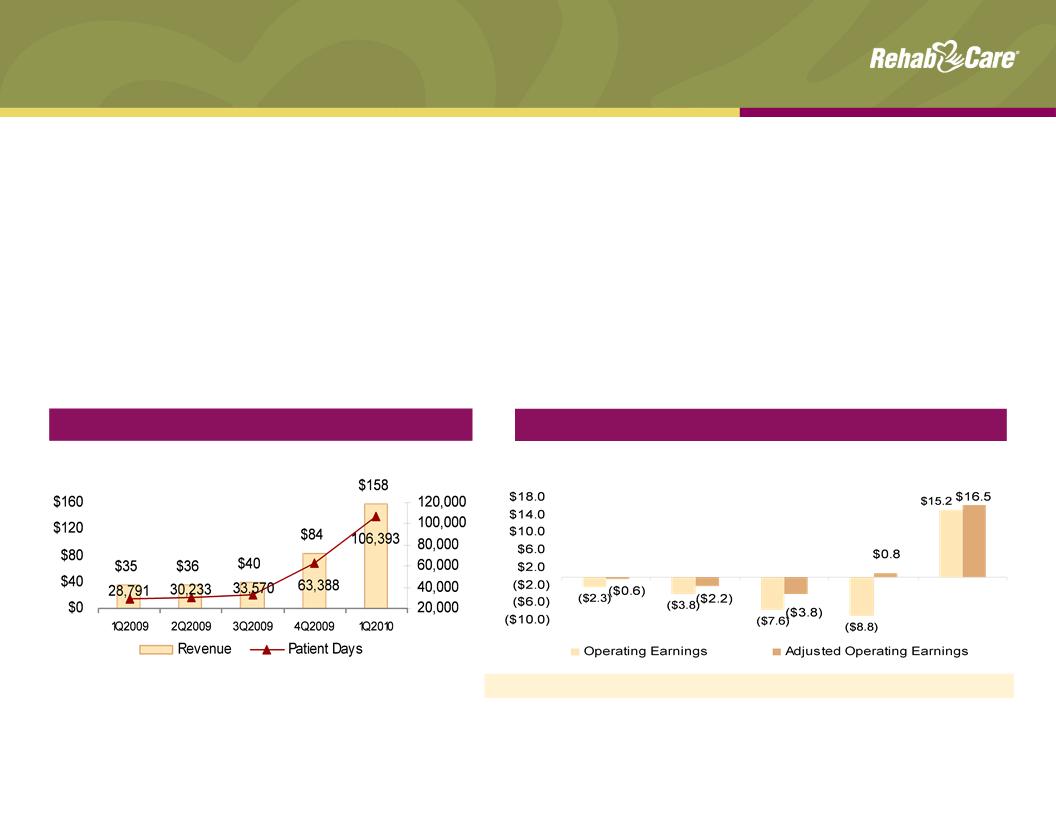
n Division historically has been impacted by de novo start-up losses and infrastructure
investments; Triumph merger provides level of critical mass as well as ability to adopt
proven operational strengths
investments; Triumph merger provides level of critical mass as well as ability to adopt
proven operational strengths
n Triumph integration and expected synergies on track; early results from incorporating
Triumph’s case management and census development methodologies are positive
Triumph’s case management and census development methodologies are positive
n In Q1 10, Triumph reported 17.7% EBITDA1 margin after slow start; legacy hospitals
sequentially improved operating loss by $3.1 mm, excluding transaction costs
sequentially improved operating loss by $3.1 mm, excluding transaction costs
Hospital Division
Performance
Performance
Operating Earnings ($ in millions)
1 See Appendix for Reconciliation to GAAP
2Includes $39.7 million in revenue and operating earnings of $3.7 million generated by Triumph
from 11/25/09 - 12/31/09
from 11/25/09 - 12/31/09
New Hospitals: 0 1 1 21 0
5
Revenue ($ in millions) and Patient Days
2
3
3
2
1Q2009 2Q2009 3Q2009 4Q2009 1Q2010
4
3Includes $112.6 million in revenue and operating earnings of $16.2 million from Triumph for
the three months ended March 31, 2010
the three months ended March 31, 2010
4 Operating earnings excluding start-up & ramp-up losses and transaction and severance
related costs, see Appendix for reconciliation to GAAP
related costs, see Appendix for reconciliation to GAAP

n Expect FY2010 revenue of $650 - $675 mm
n Anticipate EBITDA of $90 - $100 mm for FY2010
n Reflects the impact of:
n Market basket reductions for IRFs and LTACHs effective Apr. 1 and Oct. 1, 2010
n RY2011 proposed LTACH rule
n Reaffirm breakeven operating earnings run rate for 13 legacy hospitals by the end of
Q2 10 and breakeven operating earnings for FY2010
Q2 10 and breakeven operating earnings for FY2010
n Dallas LTACH anticipated to be accretive by end of Q2 10
n Triumph hospitals expected to achieve 18% to 20% EBITDA margins for FY2010
n Net income attributable to noncontrolling interests expected to approximate $3 million
for FY2010
for FY2010
n Patient Protection and Affordable Care Act (PPACA) extended LTACH provisions
contained in the 2007 Medicare, Medicaid and SCHIP Extension Act (MMSEA)
through the end of 2012 (see Appendix for summary of PPACA impact)
contained in the 2007 Medicare, Medicaid and SCHIP Extension Act (MMSEA)
through the end of 2012 (see Appendix for summary of PPACA impact)
Hospital Division
Outlook
Outlook
6
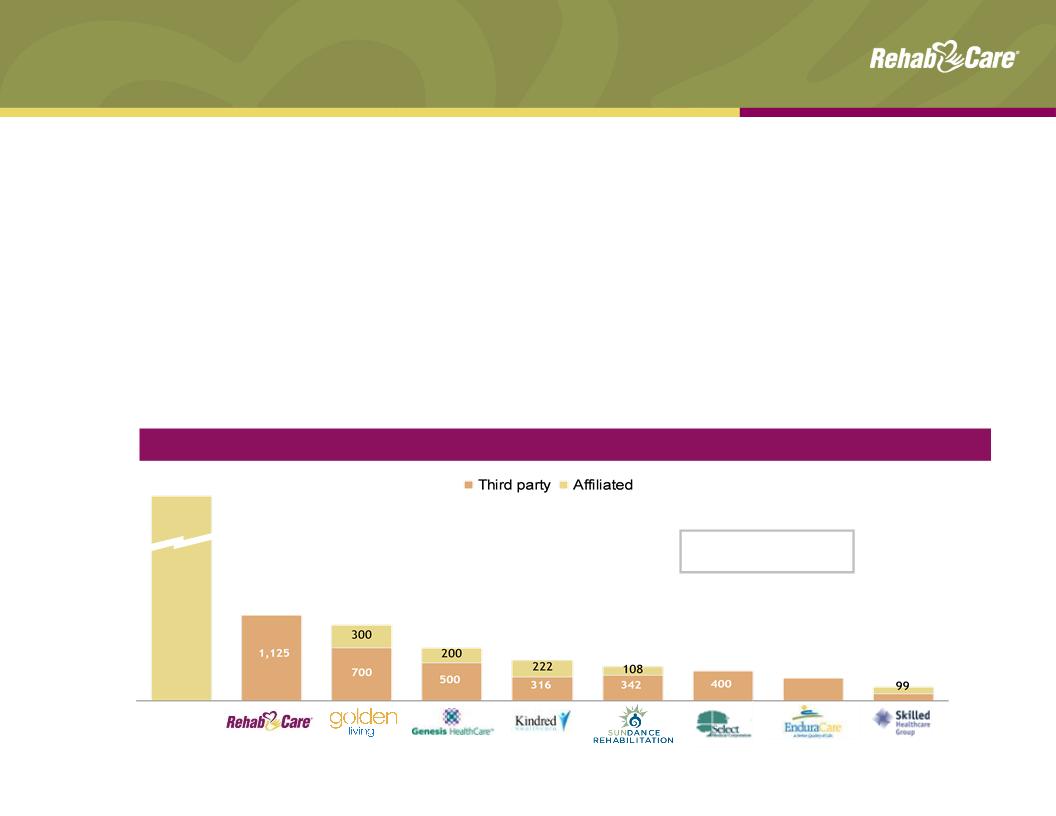
Skilled Nursing Rehabilitation Services (SRS)
Division overview
Division overview
n Manages rehab programs for SNFs
n Each Medicare-certified SNF is required to provide physical, speech and occupational therapy,
but many lack the know-how and/or scale to effectively manage a program
but many lack the know-how and/or scale to effectively manage a program
n RehabCare provides a compelling value proposition to its SNF partners
n Access to advanced technology platform
n Broader array of clinical programming
n Better access to scarce therapist labor pool
n Reimbursement expertise and denials management
Source: Information available from public filings or from company websites
¹Source: MedPAC Report to Congress, March 2010
Competitive Landscape — # of facilities served
Self-
operated
11,000+
1,125
1,000
700
538
450
400
300
188
Market Size1: 15,000+
Medicare-certified SNFs
Medicare-certified SNFs
7
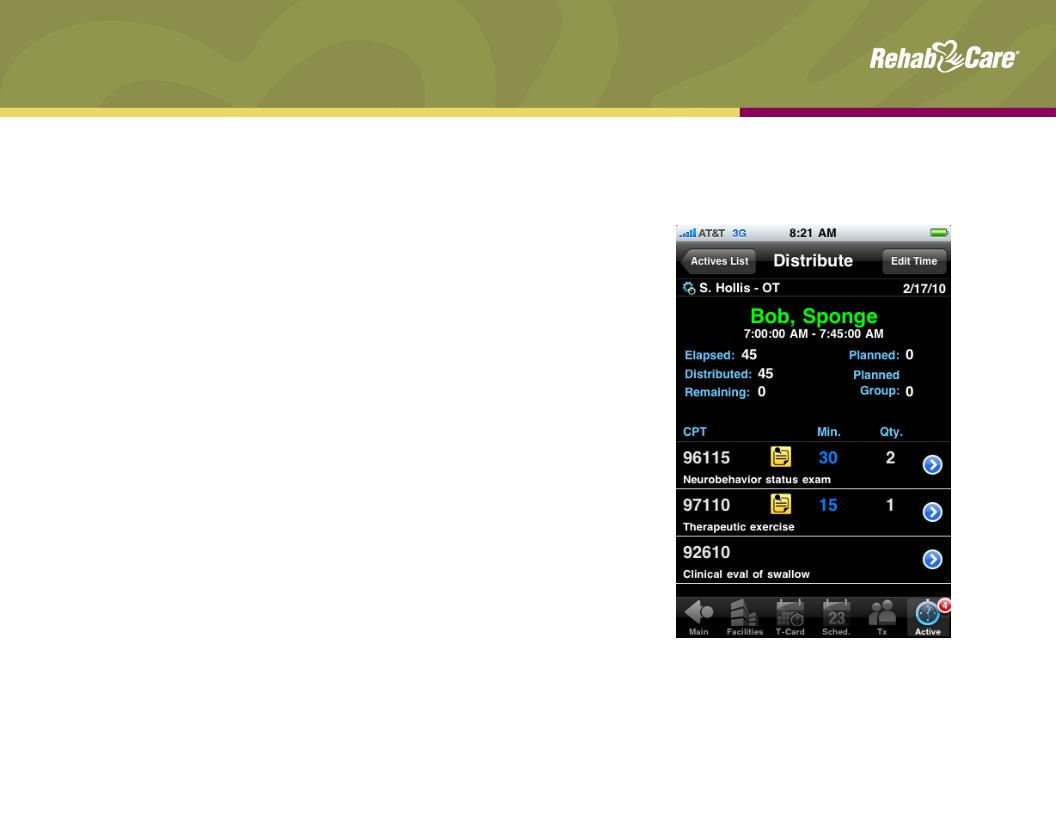
SRS Division
Advanced technology platform
Advanced technology platform
8
n Rolling out next generation point-of-service
(iTouch) technology and upgraded therapy
management platform to all programs by year
end
(iTouch) technology and upgraded therapy
management platform to all programs by year
end
n Increases speed and accuracy of data input
to maximize therapist productivity, reduce
billing errors and subsequent denials
to maximize therapist productivity, reduce
billing errors and subsequent denials
n Tracks real-time patient outcome data,
including discharge location and hospital
readmissions
including discharge location and hospital
readmissions
n Integrated Resource Utilization Group (RUG)
planner ensures appropriate RUG category
placement and appropriate payment
planner ensures appropriate RUG category
placement and appropriate payment
n Benchmarking reports provide national
comparative data and ability to track common
metrics across venues of care
comparative data and ability to track common
metrics across venues of care
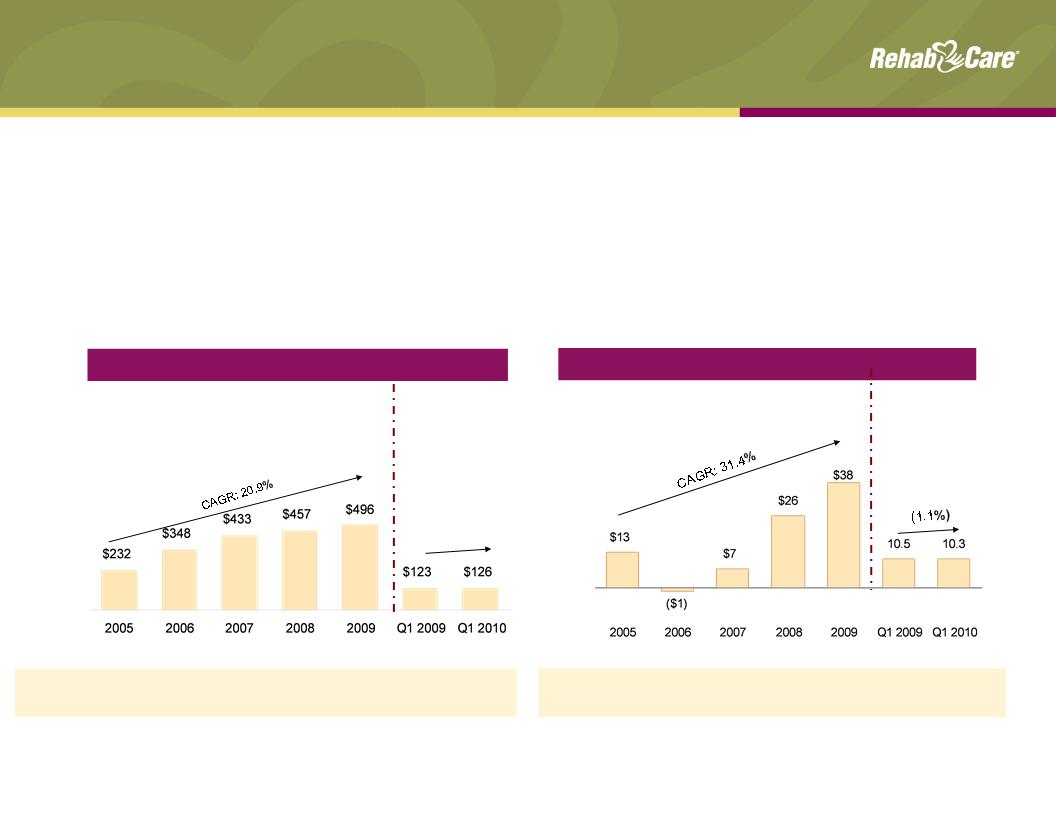
SRS Division
Performance
Performance
Note: Includes Symphony acquisition as of July 1, 2006
1Same store analysis does not include Symphony
% Margin: 5.5% (0.3%) 1.7% 5.6% 7.6% 8.5% 8.2%
Operating Earnings ($ in millions)
9
YOY growth: 35.5% 49.9% 24.4% 5.6% 8.5% 9.5% 2.6%
Same store: 8.4% 1.0%¹ 7.1%1 12.4% 8.8% 11.5% (0.6%)
n Significant same store revenue and margin growth since completion of Symphony
integration in 2007
integration in 2007
n Achieved 8.2% operating earnings margin in Q1 10, offsetting the impact of Part B
therapy caps through higher productivity and Part A volumes and better leveraging
of SG&A as a result of integrating Triumph
therapy caps through higher productivity and Part A volumes and better leveraging
of SG&A as a result of integrating Triumph
Revenue ($ in millions)
2.6%

SRS Division
Outlook
Outlook
10
n Expect 7% - 8% operating earnings margins for FY2010, driven by mid-single digit year
-over-year same store revenue growth
-over-year same store revenue growth
n Reflects the estimated impact of:
n New concurrent therapy rules that go into effect Oct. 1, 2010
n MDS 3.0 / RUGs IV implementation Oct. 1, 2010 or Oct. 1, 2011???
n Rollout of new technologies
n Pricing pressures
n Wage rate increases during the year
n Anticipate 50 to 75 net new units in 2010
n PPACA extended the Part B therapy cap exceptions process through 2010
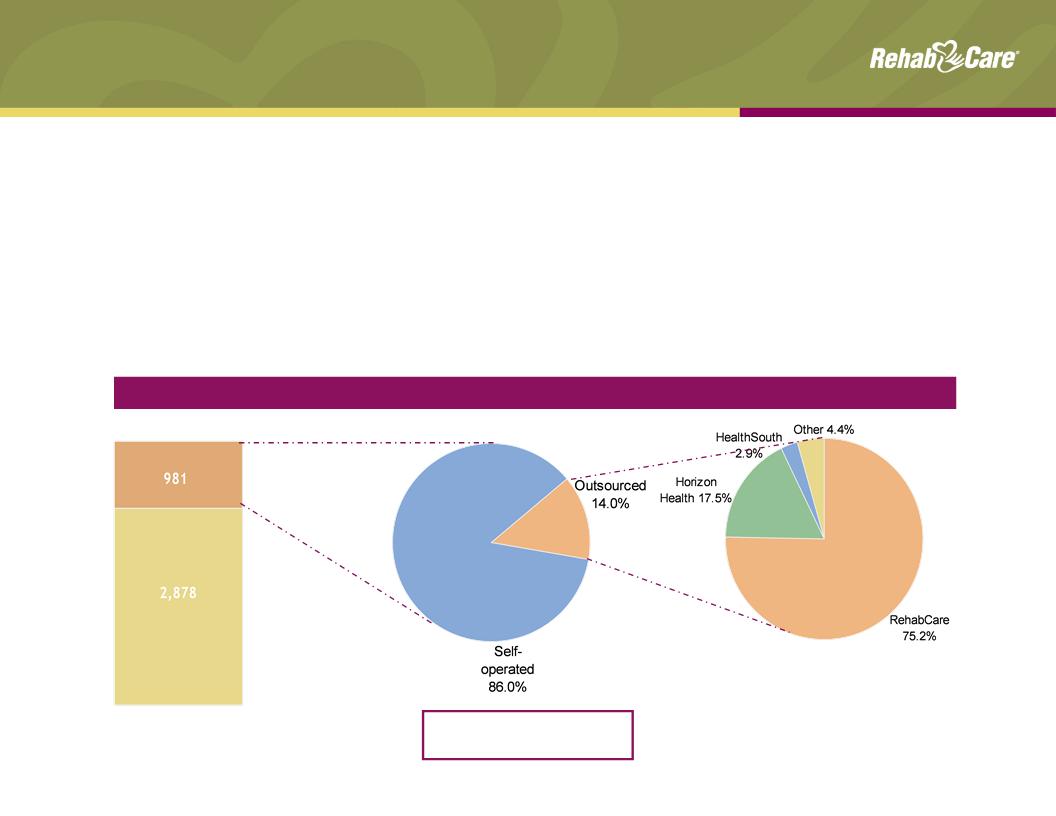
Competitive Landscape
Have IRF
No IRF
n Manages hospital-based IRFs and outpatient therapy programs on a contract basis,
providing our partners with:
providing our partners with:
n Improved internal patient flow
n Ability to attract ≈ 30% admissions from external sources
n Successful clinical outcomes and broader clinical programming (brain, stroke, spinal dysfunction)
n Regulatory compliance (60% rule, RAC, 3-hour rule)
n Recruiting and labor management
3,8592 short-term acute
care hospitals
care hospitals
137 outsourced
Hospital Rehabilitation Services (HRS)
Division overview
Division overview
Market Size1: 981 hospital
-based IRFs
-based IRFs
Source: Information available from public filings or from
company websites
company websites
1MedPAC March 2010 Report to Congress
²American Hospital Directory
11

12
HRS Division
Performance
Performance
n Improved same store revenues and discharges in Q1 10 and achieved 16%
operating earnings margin; net unit count declined by one sequentially
operating earnings margin; net unit count declined by one sequentially
¹Includes $1.2 mm pretax charge from a bad debt write-down related to an
outpatient transaction
outpatient transaction
YOY growth: (0.5%) (5.3%) (8.7%) 0.9% 7.6% 7.2% 0.4%
IRFs: 120 115 107 113 106 113 103
Operating Earnings ($ in millions)
% Margin: 11.9% 13.2% 14.0% 13.3% 16.6% 14.6% 16.0%
1
Revenue ($ in millions)
CAGR: (1.6%)
0.4%
9.9%
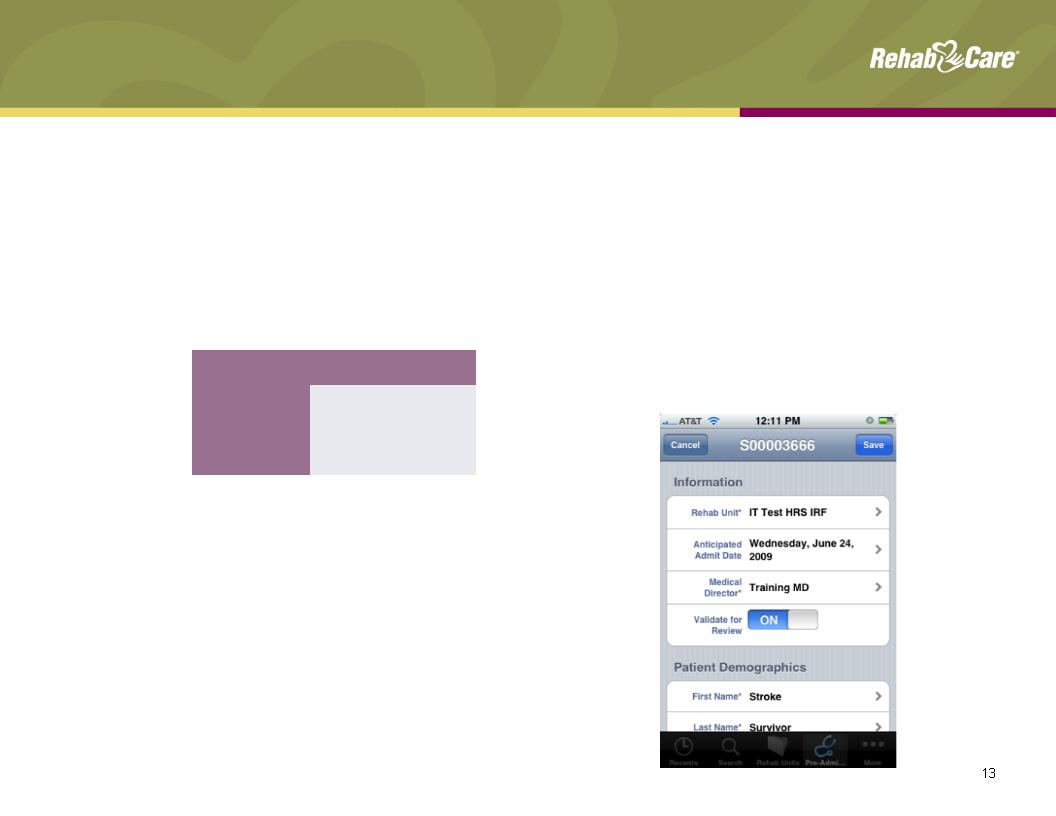
HRS Division
Outlook
Outlook
n Expect 15% - 17% operating earnings margin for FY2010
n Anticipate 2 - 4% year-over-year growth in IRF same store discharges for
FY2010
FY2010
n Unit count expected to decrease in first half of year with recovery in second,
resulting in flat unit growth for year
resulting in flat unit growth for year
n 12 known unit openings YTD 2010 vs. 6 openings for TY2009
n Enhancing client value proposition through expanded
product offerings that better serve the needs of the
market
product offerings that better serve the needs of the
market
n Applying enabling technology, including:
n Electronic pre-screen to increase speed of admissions,
drive volumes
drive volumes
n Point-of-service technology to improve productivity and
regulatory compliance
regulatory compliance
n Upgraded inpatient outcomes management system to
enhance patient data tracking and provide benchmarking
capabilities
enhance patient data tracking and provide benchmarking
capabilities
|
Openings
|
YTD 2010
|
TY 2009
|
|
IRF
|
6
|
5
|
|
Skilled Nursing
|
4
|
0
|
|
Outpatient
|
2
|
1
|
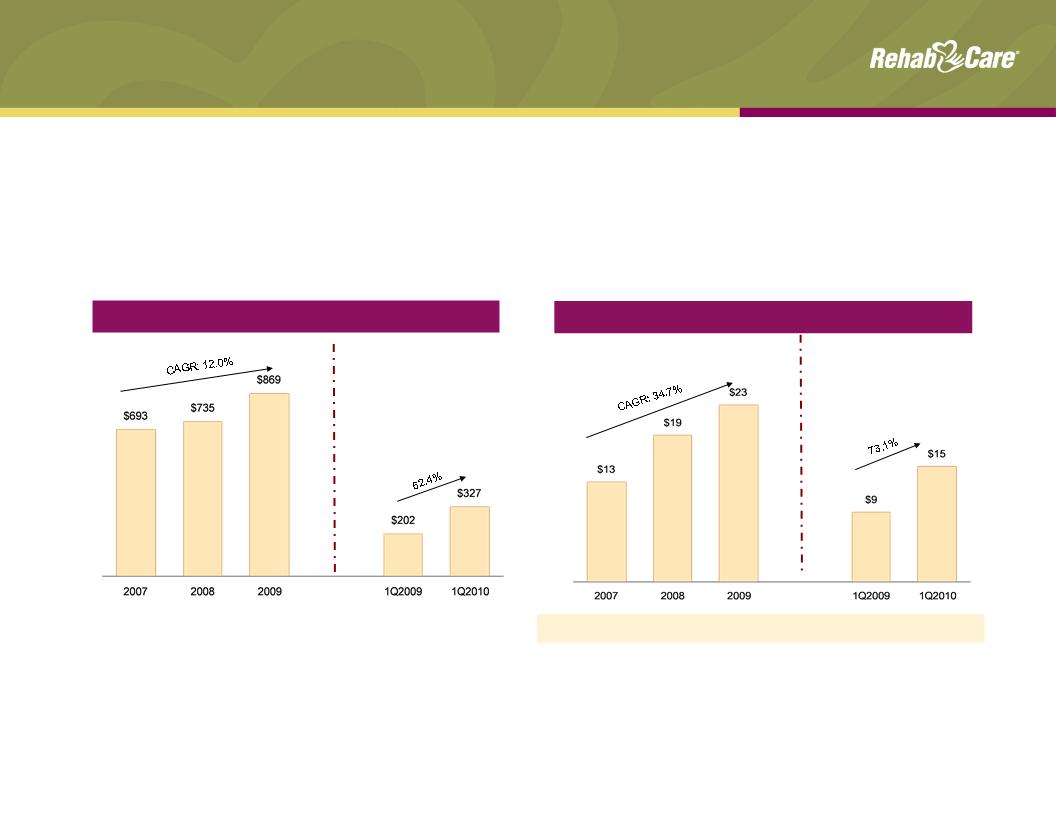
Revenue ($mm)
Net Earnings ($mm)
EPS: $0.732 $1.05³ $ 1.224 $0.48 $0.61
14
Consolidated Financial Summary
1RehabCare 2009 historical includes $39.7 million in revenue generated by Triumph
2Includes $0.17 per diluted share impairment charge on an intangible asset
3Includes $0.09 per diluted share in charges related to a bad debt write-down of an
outpatient transaction and cancellation of a planned acquisition and development project
outpatient transaction and cancellation of a planned acquisition and development project
4Includes transaction and severance related charges related to Triumph of $0.38 per
diluted share.
diluted share.
¹
n Anticipate strong consolidated revenue and net earnings growth for the full year
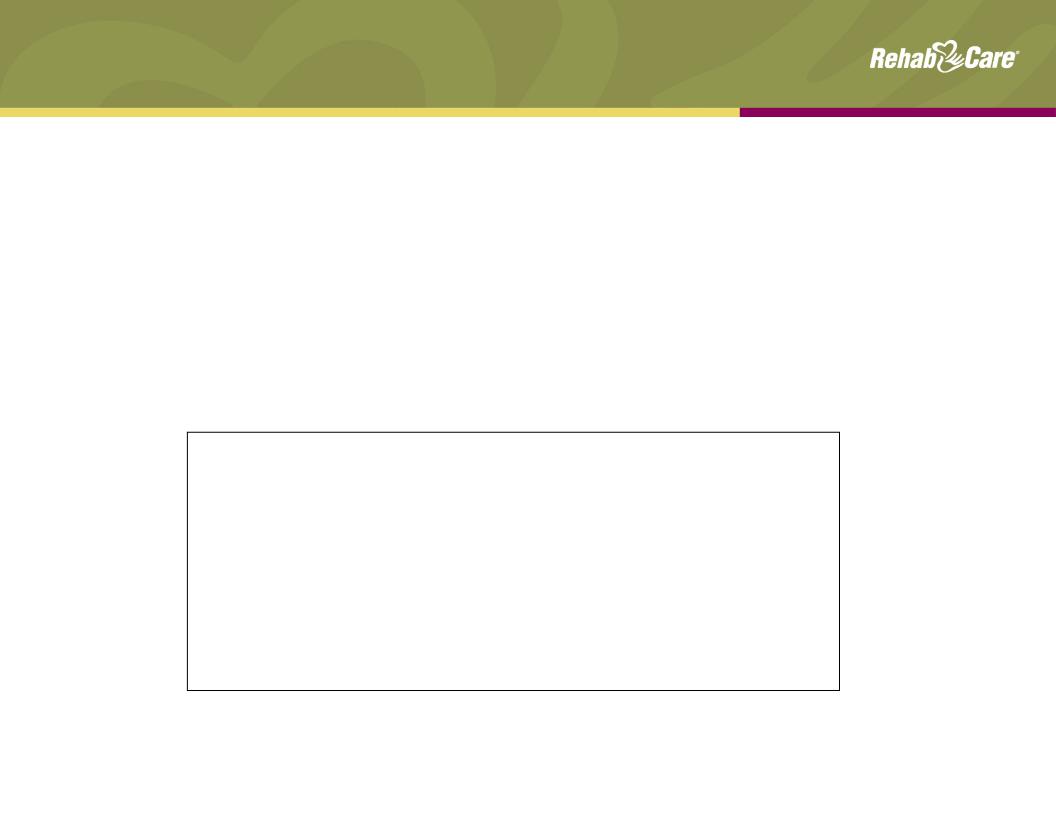
15
Consolidated Balance Sheet
n Cash flow from operations was $8.5 mm for three months ended Mar. 31,
2010 compared with $9.4 mm in the prior year period
2010 compared with $9.4 mm in the prior year period
n Days sales outstanding was 61.8 days at Mar. 31, 2010 compared to 60.2 days at
Dec. 31, 2009
Dec. 31, 2009
n Expect continued strong operating cash flow with DSO of approximately 60 -
63 days
63 days
n Capital expenditures anticipated to be $32 mm in 2010, consisting of $12.5
mm of information system investments; $12.5 mm in expansion projects and
$7 mm related to maintenance
mm of information system investments; $12.5 mm in expansion projects and
$7 mm related to maintenance
Cash and Cash Equivalents
Total Assets
Total Debt
Stockholders’ Equity
Noncontrolling Interests
Percent of Debt to Total Capital¹
($mm)
$ 27.4
1,124.9
453.8
453.6
22.6
49%
3/31/10
1Total capital represents the sum of debt, stockholders’ equity and noncontrolling interests

16
Safe Harbor
Forward-looking statements have been provided pursuant to the safe harbor
provisions of the Private Securities Litigation Reform Act of 1995. Such statements
are based on the Company’s current expectations and could be affected by
numerous factors, risks and uncertainties discussed in the Company’s filings with
the Securities and Exchange Commission, including its most recent report on
Form 10-K, subsequent reports on Form 10-Q and current reports on Form 8-K.
Do not rely on forward looking statements as the Company cannot predict or
control many factors that affect its ability to achieve the results estimated. The
Company makes no promise to update any forward looking statements whether as
a result of changes in underlying factors, new information, future events or
otherwise.
provisions of the Private Securities Litigation Reform Act of 1995. Such statements
are based on the Company’s current expectations and could be affected by
numerous factors, risks and uncertainties discussed in the Company’s filings with
the Securities and Exchange Commission, including its most recent report on
Form 10-K, subsequent reports on Form 10-Q and current reports on Form 8-K.
Do not rely on forward looking statements as the Company cannot predict or
control many factors that affect its ability to achieve the results estimated. The
Company makes no promise to update any forward looking statements whether as
a result of changes in underlying factors, new information, future events or
otherwise.

Appendix
17
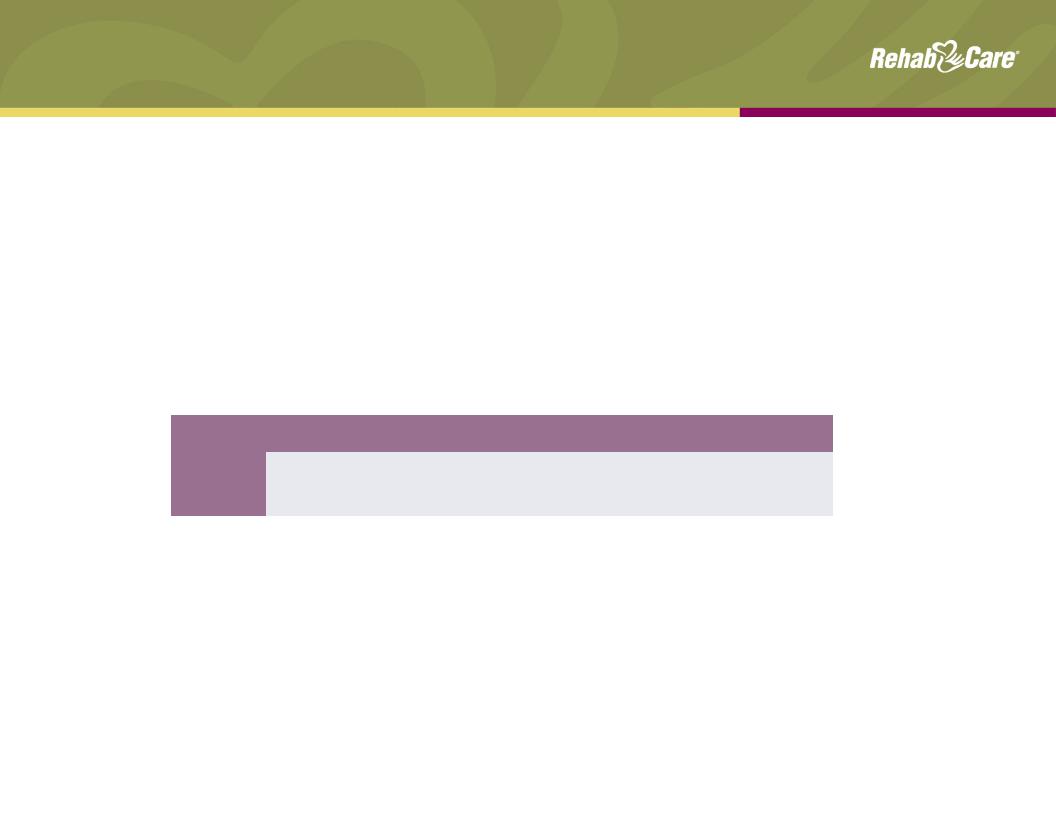
Impact of Healthcare Reform
n Extends LTACH provisions of MMSEA through Dec 2012
n Maintains existing status related to 25% Rule and short-stay outliers
n Delays one-time budget neutrality adjustment (estimated at 3.75%)
n Continues moratorium on new LTACH beds while facility criteria is established
n Extends auto exception process for Part B therapy caps through Dec. 31, 2010
n Delays implementation of RUGs IV until Oct. 1, 2011
n Establishes reductions in market basket updates for IRFs and LTACHs
n Productivity (negative) adjustments for SNFs, IRFs and LTACHs beginning in 2012
n Prohibits physician ownership of hospitals, effective Dec. 31, 2010, and creates
new transparency, reporting and expansion requirements for “grandfathered”
hospitals
new transparency, reporting and expansion requirements for “grandfathered”
hospitals
18
|
|
Apr. 1, 2010
|
RY 2011
|
RY 2012-13
|
RY 2014
|
RY 2015-16
|
RY 2017-19
|
|
IRF
|
0.25
|
0.25
|
0.10
|
0.30
|
0.20
|
0.75
|
|
LTACH
|
0.25
|
0.50
|
0.10
|
0.30
|
0.20
|
0.75
|

Impact of Healthcare Reform
n Beginning in 2012, allows providers organized as Accountable Care Organizations
that voluntarily meet quality thresholds to share in cost savings achieved in
Medicare program
that voluntarily meet quality thresholds to share in cost savings achieved in
Medicare program
n Establishes a national pilot program by 2013 to study effectiveness of bundled
payment system for hospital+physician+post-acute services delivered three days
prior to hospitalization through 30 days post-discharge
payment system for hospital+physician+post-acute services delivered three days
prior to hospitalization through 30 days post-discharge
n In 2015, establishes Medicare Independent Payment Advisory Board (IPAB); IRFs
and LTACHs exempt from any binding proposals of IPAB
and LTACHs exempt from any binding proposals of IPAB
19
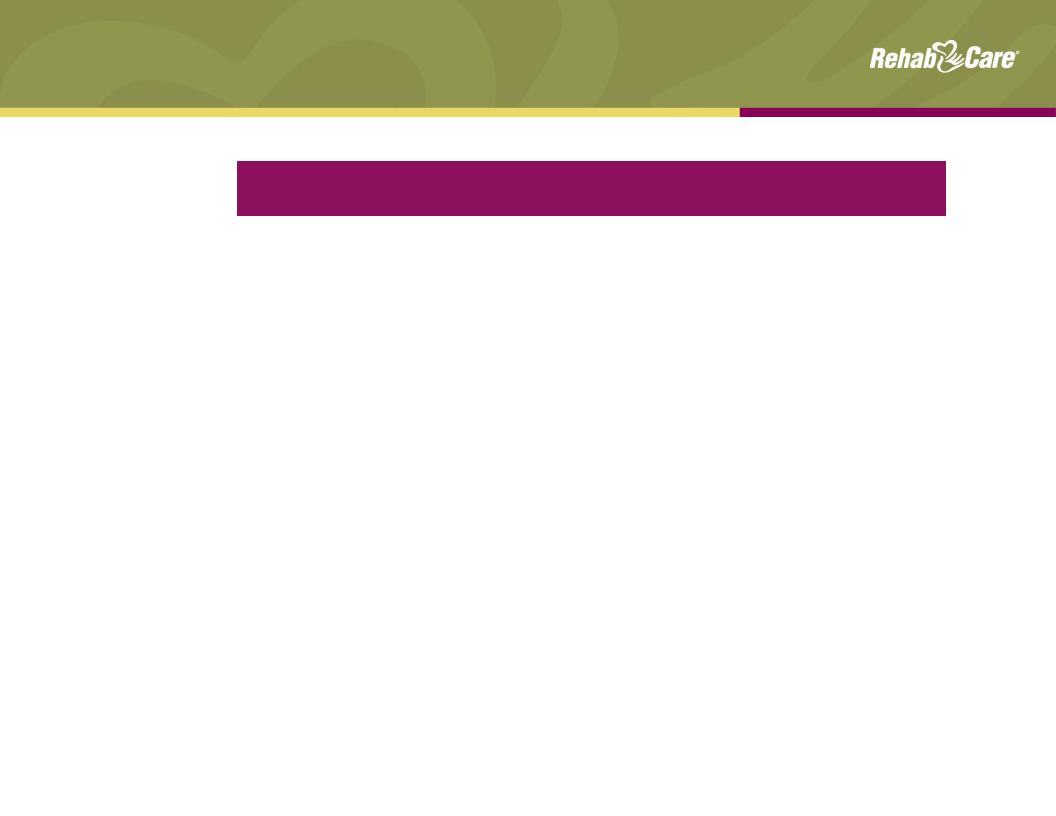
20
Primary Post-Acute Settings
Overview
Overview
|
|
Long-Term Acute Care Hospitals
|
Skilled Nursing Facilities
|
Inpatient Rehab Facilities
|
|
Medicare
Spending 2009 |
$4.6 billion
|
$25.5 billion
(est. $6 billion rehab) |
$5.8 billion
|
|
Patients Served
2008 |
130,869 Medicare discharges
|
2.6 million Medicare admissions
|
370,048 Medicare discharges
|
|
Type of Patient
|
High acuity, at least 25 days
|
Low to moderate acuity, may
require some rehab |
High acuity, requires extensive
rehab (min 3 hrs/day) |
|
Avg. Length of
Stay |
At least 25 days
|
27 days
|
13.2 days
|
|
Medicare
Reimbursement |
LTACH PPS - Receive a single payment
when Medicare beneficiary is discharged for all services rendered |
SNF PPS - Receive a per diem
payment under both Medicare Part A and state Medicaid programs |
IRF PPS- Receive a single
payment when Medicare beneficiary is discharged for all services rendered |
|
Medicare
Requirements |
• Patients must have an average length
of stay of >25 days • 25% rule: no more than 25% of
patients may be referred from a single source (fixed at 50% through 2012) • Moratorium on new LTACH beds until
2013 |
Medicare covers up to 100 days
of SNF care following an acute hospital stay of at least 3 days |
60% Rule: 60% of patients
must satisfy one of 13 defined conditions |
Source: MedPAC
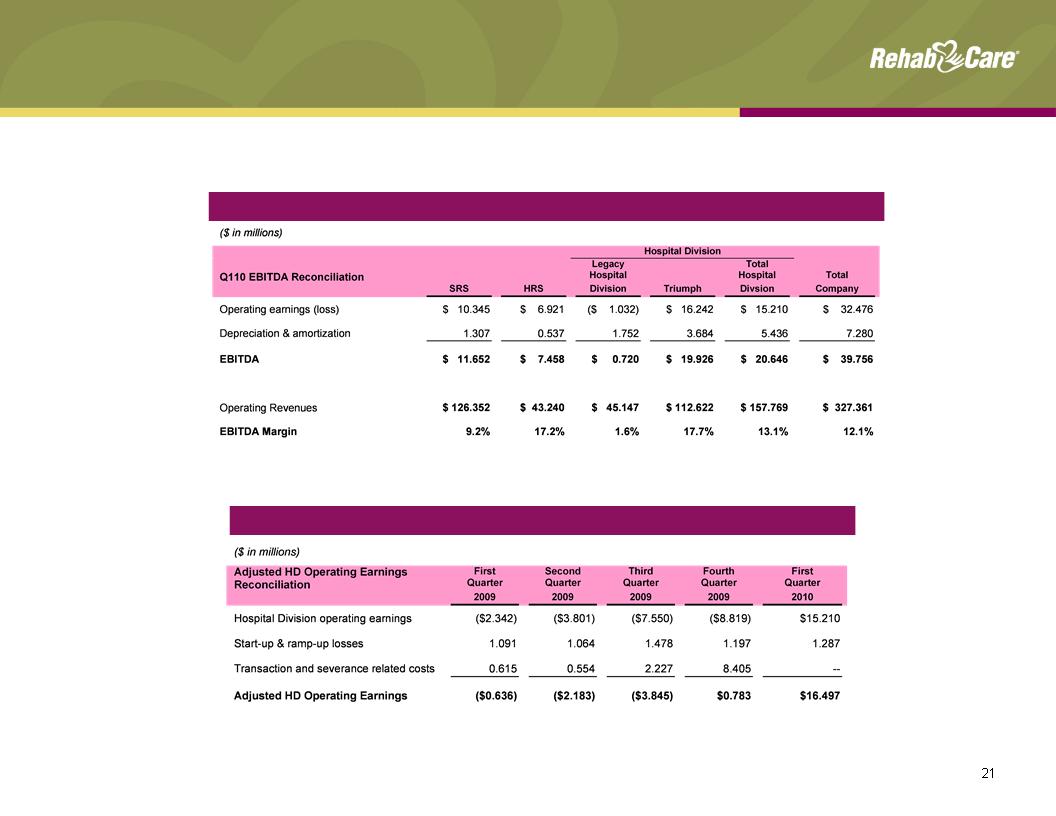
Q110 EBITDA and Hospital Division Adjusted
Operating Earnings Reconciliations
Operating Earnings Reconciliations
Hospital Division Adjusted Operating Earnings
Q110 EBITDA Reconciliation
